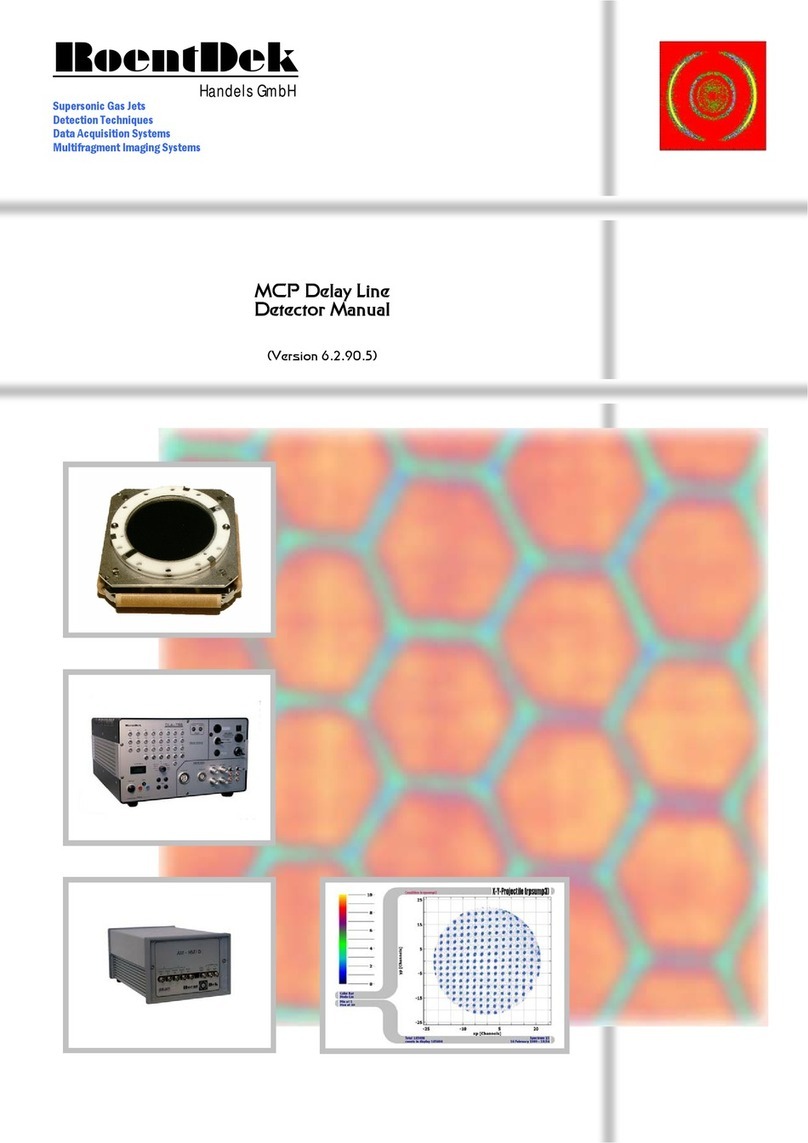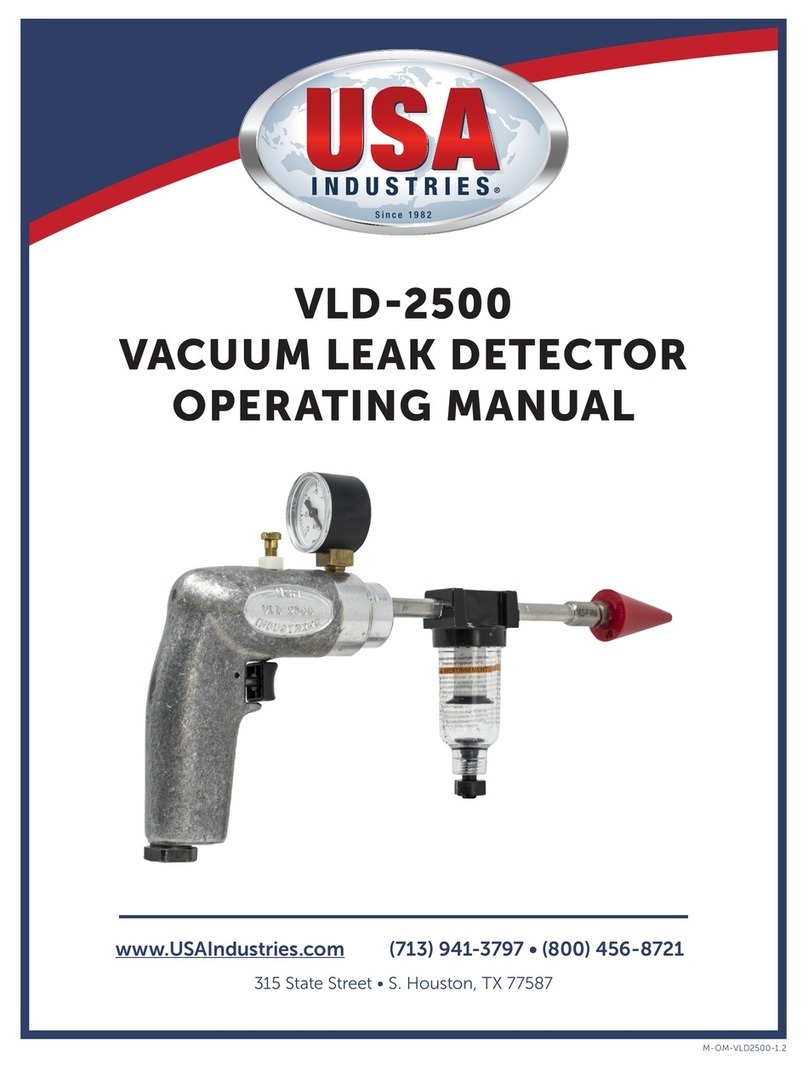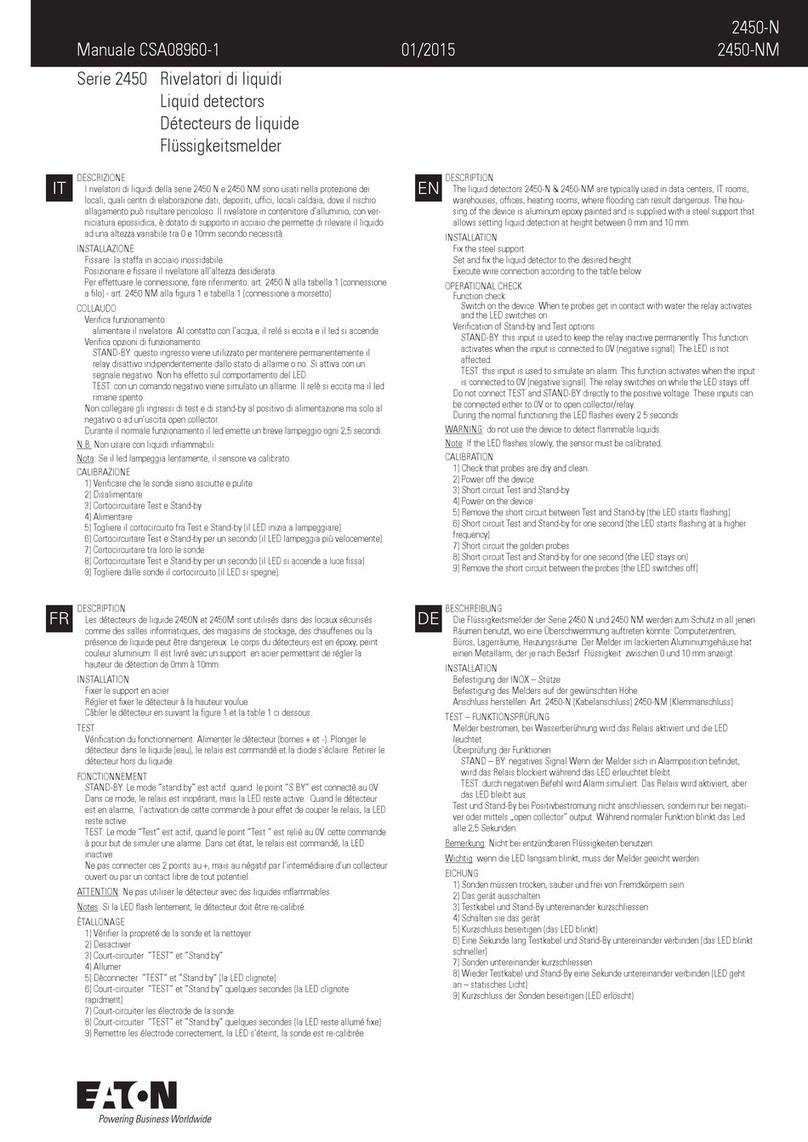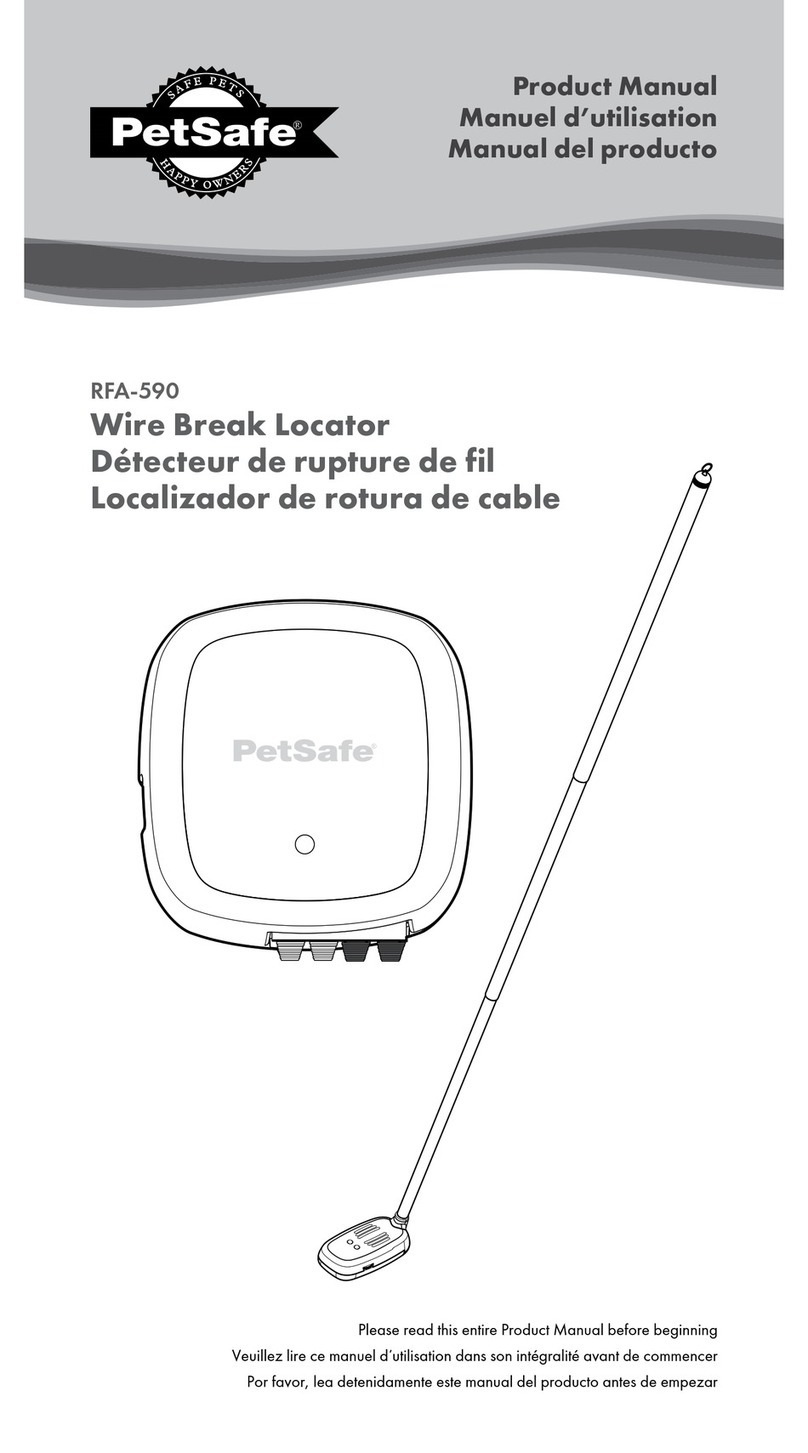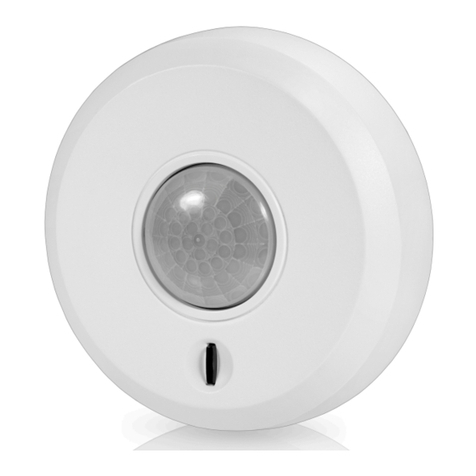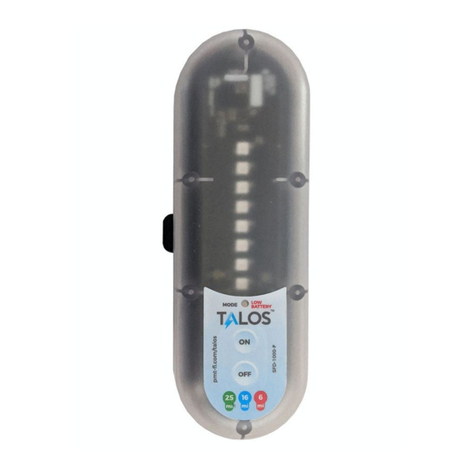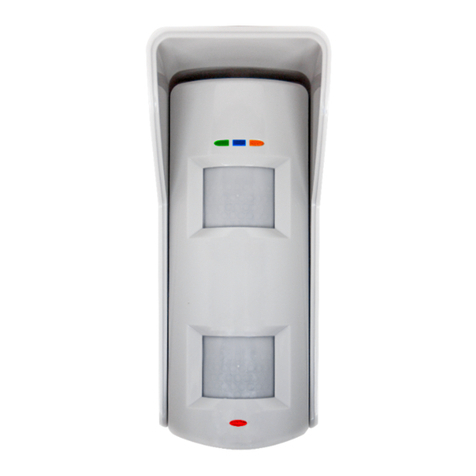RoentDek DLD40 User manual

RoentDek
HandelsGmbH
Supersonic Gas Jets
Detection Techniques
Data Acquisition Systems
Multifragment Imaging Systems
MCP Delay Line
Detector Manual
(Version 11.0.1304.1)

Mail Addresses:
Headquarter
RoentDek Handels GmbH
Im Vogelshaag 8
D-65779 Kelkheim-Ruppertshain
Germany
Frankfurt branch
RoentDek Handels GmbH
c/o Institut für Kernphysik
Max-von-Laue-Str. 1
D-60438 Frankfurt am Main
Germany
Web-Site:
www.roentdek.com
WEEE:
DE48573152
Product names used in this publication are for identification purposes only and may be trademarks of their respective companies.
All rights reserved. Technical changes may be made without prior notice. The figures are not binding.
We make no representations or warranties with respect to the accuracy or completeness of the contents of this publication.
Page 2 of 83 MCP Delay Line Detector Manual (11.0.1304.1)

Table of Contents
DETECTOR SYSTEM - COMPONENTS.......................................................................................................................5
1THE MICROCHANNEL PLATE DETECTOR WITH DELAY-LINE ANODE................................................7
1.1 GENERAL DESCRIPTION.........................................................................................................................................8
1.1.1 Position Encoding.........................................................................................................................................8
1.1.2 Timing information:.................................................................................................................................... 10
1.2 ASSEMBLY OF THE MCP-DETECTOR ...................................................................................................................11
1.2.1 List of Detector Assembly Parts..................................................................................................................11
1.2.2 Preparation.................................................................................................................................................11
1.2.3 Connecting the Wires to the Delay-line Anode...........................................................................................12
1.2.4 Assembly of the MCP-stack.........................................................................................................................14
1.2.4.1 Assembly of the MCP-stack for the DLD40, DLD80 and HEX80 ...........................................................................14
1.2.4.2 Assembly of the MCP-stack for the DLD120 and HEX120 .....................................................................................18
2MOUNTING OF THE DETECTOR AND CABLE CONNECTIONS VIA VACUUM FEEDTHROUGH....23
2.1 MOUNTING OF THE DETECTOR ON A VACUUM-FLANGE ...................................................................................... 23
2.2 CONNECTING THE SIGNAL CABLES TO A FEEDTROUGH FLANGE .........................................................................25
2.3 THE FT12TP (HEX)–FEEDTHROUGH FLANGE WITH SIGNAL DECOUPLER ..........................................................26
2.4 THE FT4(TP) FOR FT16(TP) AND DET40/75......................................................................................................29
2.5 OPERATION OF THE MCP DETECTOR WITH DELAY-LINE (OR TIMING)ANODE ......................................................30
2.5.1 Initial Startup Procedure............................................................................................................................30
2.5.2 General Operation......................................................................................................................................32
3THE FRONT-END TIMING ELECTRONICS MODULES: AMPLIFIER & CFD MODULE.......................35
3.1 SIGNAL INPUTS AND AMPLIFICATION ................................................................................................................... 36
3.2 THE DLATR BOARD............................................................................................................................................38
3.3 CFD CONTROLS AND OUTPUTS ............................................................................................................................ 38
3.4 CONNECTING AND OPERATING THE ATR19.........................................................................................................40
3.5 OPENING THE ATR19 MODULE............................................................................................................................ 41
3.6 THE ATR19-2(B)MODULE ..................................................................................................................................42
3.7 FINAL ADJUSTMENT FOR DETECTOR OPERATION .................................................................................................43
3.8 THE SPS1(B)MAINS ADAPTER.............................................................................................................................46
3.8.1 Connecting the SPS1...................................................................................................................................46
3.8.2 How to switch the AC supply voltage..........................................................................................................47
3.8.3 Output voltage adjustment.......................................................................................................................... 48
3.8.4 Maintenance and Troubleshooting .............................................................................................................48
3.8.5 Technical Specifications .............................................................................................................................49
3.9 TROUBLESHOOTING THE ATR19’S INTERNAL MAINS POWER SUPPLY ..................................................................49
4DATA ACQUISITION HARD- AND SOFTWARE..............................................................................................53
4.1 THE TIME-TO-DIGITAL-CONVERTERS (TDC) FOR PC..........................................................................................53
4.1.1 TDC8HP .....................................................................................................................................................53
4.1.2 The HM1 / HM1-B ...................................................................................................................................... 54
4.1.3 The TDC8....................................................................................................................................................55
4.2 HARD-AND SOFTWARE INSTALLATION ...............................................................................................................55
4.2.1 TDC8HP .....................................................................................................................................................55
4.2.2 HM1 / HM1-B............................................................................................................................................. 56
4.2.3 TDC8........................................................................................................................................................... 57
4.3 CONNECTING THE ATR19 OR CFD WITH THE TDC.............................................................................................57
4.3.1 TDC8HP (or TDC8) ................................................................................................................................... 58
4.3.2 HM1 / HM1-B............................................................................................................................................. 58
4.4 STARTING THE COBOLDPC 2011 R3 SOFTWARE: ................................................................................................58
4.4.1 Hardware specific commands: DAq-parameters and coordinates............................................................. 61
4.4.2 Analysis specific commands: DAn parameters and coordinates ................................................................62
4.4.3 Spectra and condition definition commands...............................................................................................65
5HIGH VOLTAGE SUPPLIES................................................................................................................................. 69
MCP Delay Line Detector Manual (11.0.1304.1) Page 3 of 83

5.1 THE HV 2/4 DUAL HIGH VOLTAGE SUPPLY MODULE........................................................................................... 69
5.2 THE BIASET3 WITH SPS2(MINI).........................................................................................................................71
5.3 BA3 BATTERY UNIT.............................................................................................................................................73
5.4 HVT AND HVT4 HIGH VOLTAGE TERMINATORS................................................................................................ 74
5.5 HVZ VOLTAGE DIVIDER UNIT ..............................................................................................................................75
APPENDIX: (MCP’S):.....................................................................................................................................................79
LIST OF FIGURES..........................................................................................................................................................81
LIST OF TABLES............................................................................................................................................................ 83
LIST OF EQUATIONS....................................................................................................................................................83
Page 4 of 83 MCP Delay Line Detector Manual (11.0.1304.1)

Detector System - Components
This manual describes all major components of the RoentDek delay-line detector system as it can be delivered for the
DLD40(EP), DLD80(75eT), HEX80/HEX75 and DLD120 and HEX120(100) detector. Even if you have not purchased
the complete system you will find valuable information in the chapters describing the different components about the link
between the components and the operation. However, you might have received only the relevant parts of this manual.
1. DLD or HEXmicrochannel plate detector with delay-line anode
0. FT12(16)TP 12-pin CF35 (and fourfold MHV) UHV-feedthrough flange(s) with signal decouplers and (optional)
flange mounting gear on DNxxxCF flange with CF35 ports (xxx = 100 – 300)
0. ATR19 fast (differential) amplifier unit with integrated constant-fraction-discriminator (default) or
FAMP8 (or similar) amplifier unit, CFD8c/7x: (or similar) constant-fraction-discriminator modules (for download)
0. TDC8HP or HM1 time to digital converter and
CoboldPC
read-out software (default) or
fADC4/8 fast ADC units (for download)
Error! Reference source not found.. HV2/4,BIASET3 or similar high voltage supply assembly and
BA3/HVT/HVZ auxiliary bias units.
Please follow the link http://www.roentdek.com/manuals for device specific manuals.
If you have received special detector components, i.e. a detector of different size or type, or other electronic modules you will
find a separate manual commenting on peculiarities of your special system. In this case the information given here is mostly
relevant for your system but you might need extra information. Please also refer to the FAQ document on the web page.
Please always check our web site for updates after you have received our products or contact RoentDek.
MCP Delay Line Detector Manual (11.0.1304.1) Page 5 of 83

Page 6 of 83 MCP Delay Line Detector Manual (11.0.1304.1)

1
The Microchannel Plate Detector with delay-line anode
The Micro-Channel Plate detector with delay-line anode is a device for single particle/photon counting, giving information on
the position of each particle/photon and its impact time with high precision. It uses an electronic read-out scheme employing
fast timing amplifiers, timing discriminators and digitizers. It operates under ultra-high vacuum and requires high voltage
supplies.
This detector system is modular and com in different sizes and versions.
Typical performance:
position resolution < 0.1mm
overall linearity 0.3mm
rate capability 1MHz
multi-hit dead time 10-20ns
Typical characteristics of MCPs (for DLD40EP, DLD75eT and HEX75 see below)
# of MCPs in stack 2
Outer Diameter: 50/86.6/127mm
Active Diameter: 45/80/120mm
Aspect Ratio L/D 60:1
Thickness 1.5mm
Pore size 25µm
Center-to-center spacing: 32µm
Bias Angle: 8° ±1°
Open Area Ratio: >50%
for DLD40EP MCP: 40mm OD (>40mm active), L/D 80:1 , 1mm thickness, 13µm pore size, bias angle: 20°, OAR > 70%
for DLD75eT MCP: 86.7mm OD (75mm active), L/D 80:1; 1mm thickness, 13µm pore size, bias angle: 19°, OAR 64%
for HEX75 MCP: 86.7mm OD (75mm active),L/D 40:1; 1mm thickness, 26µm pore size, bias angle: 20°, OAR 70%
The HEX75 uses triple MCP stacks (Z-stacks). Other detectors can also be delivered with triple MCP stacks (option …/Z)
The HEX120 can also be delivered as HEX100 with 114mm OD MCP (105mm active), 26µm pore size, bias angle: 20°, OAR
70%
Typical characteristics of the detector assembly
Height above a mounting Flange: about 100mm (adjustable)
Mounting Diameter: 94/144/196/246mm
Operating Temperature Range: -50 to 70°C
Operating Pressure: < 2 x 10-6mbar
Baking Temperature: 150°C Maximum
Electron Gain @ 2400Volts*: 107Minimum
If you have chosen a detector set with central hole, its size in the MCP is usually 6.4mm and the minimum active diameter
9mm.
If you have chosen a different custom detector type, e.g. DLD25, DLD80x100, DLD100, DLD150, or HEX40 please refer
to the separate instructions.
*For DLD40EP, DLD75eT or /Z options: about 300V higher voltages may be applied.
MCP Delay Line Detector Manual (11.0.1304.1) Page 7 of 83

1.1 General Description
The RoentDek MCP detector with delay-line anode is a high resolution 2D-imaging and timing device for charged particle
or photon detection at high rates with limited multi-hit capability. The linear active diameter is at least 40mm for the detectors
with the DL40 anode (e.g. DLD40 and DLD40EP), 75mm for the DL80 anode (e.g. DLD80 and DLD75eT), and about
120mm for the DLD120. The RoentDek Hexanode has a third delay-line layer that gives redundant detection opportunities
either to improve the multi-hit performance, linearity or to allow the use of a MCP setup with central hole and minimized blind
detection area. In its usual version (HEX80) it has about 75mm redundant detection area (HEX120: 100mm redundant, up to
115mm linear with at least two layers, total up to 120mm, HEX100: 100mm redundant detection area, HEX40about 40mm
redundant detection area)*. For detectors with central hole (e.g. HEX40/o and HEX80/o) the descriptions in this manual are
also relevant unless otherwise stated. A DLD150 version is available on demand with 150mm active detection diameter.
The detector consists of a pair of selected MCPs in chevron configuration or of a triple stack (Z-stack) and a helical wire delay-
line anode for two-dimensional position readout. The MCPs are either supported by a pair of partially metalized ceramic rings
(1.5/2mm thick, 65/105mm outer diameter for DLD40/DLD80 and HEX80 with metal contacts on the ceramic rings are
suitable for soldering, clamping or spot welding) or the MCP stack is mounted between a metal front ring and a (usually square-
shaped) rear side holder plate, e.g. for the DLD120 and HEX120(100) or custom MCP stack designs.
Operation requires two DC voltages for a (resistance matched) MCP stack on front and back contacts and three voltages for
the anode’s support plate (“holder”) and the anode wire array. All voltages can be supplied by separate HV-supplies or voltage
dividers. The baking limit is specified as 150°C for the detectors and for optionally provided in-vacuum cables and feedthroughs.
The wire array consists of two or three helical wire propagation double (delay) lines. For each dimension a differential wire pair
is formed by a collection (signal) wire and a reference wire. A potential difference of 20V to 50V between signal and reference
wire ensures that the electron cloud emerging from the MCP is mainly collected on the signal wires, shared between the wire
layers for different position encoding directions. The anode holder has to be biased with an intermediate potential with respect
to the anode wires and the MCP back potential to ensure proper charge cloud propagation and spatial broadening in the drift
zone between MCP and anode wires. The optimal voltage depends on the distance between the MCP holder plate and the
anode wires.
Typically the wires should have about 300V more positive potential than MCP back side and the holder about +100V with
respect to the MCP back potential.
Avoid penetration of strong external electrical and magnetic fields into the electron cloud drift region (between MCP and wire
anode). Electrical fringing fields can produce image distortions, magnetic fields (> 50Gauss) disturb the proper charge cloud
broadening and will lead to malfunction of the anode.
1.1.1
Position Encoding
The position of the detected particle/photon is encoded by the signal arrival time difference at both ends of each parallel-pair
delay-line, for each layer independently. While the signal speed along the delay line is close to speed of light, one can define a
perpendicular signal speed v⊥given by the pitch of one wire loop (typically 1mm) and the time, which a signal needs to propagate
though this loop. This defines the single pitch propagation time per 1mm which is equal to 1/v⊥(in units mm/ns).
The corresponding ends of the delay-lines for each dimension are located on the opposite corners of the wire array terminals
on the rear side. The electrical resistance of each wire is between 5 and 100Ωend-to-end, depending on the size of the delay-
line and the wire type used. Corresponding ends of wires can such be identified. The four (or six) terminal pairs have to be
connected to vacuum feedthroughs by a twisted-pair cable configuration (both cables of a pair must have equal lengths, within
5mm). From the feedthroughs the signals must be transmitted (after DC-decoupling) to a differential amplifier or signal
transformer with equally adequate transmission cables.
The difference between the signal arrival times at the adjacent ends of each delay-line is proportional to the position on the
MCP in the respective dimension. The sum of these arrival times is fairly constant with few ns for each event (see below). The
time sequence of the signals can be measured by time-to-amplitude converters (TAC) or an n-fold time-to-digital converter
(TDC), n is at least 4 or up to 7 (Hexanode with separate timing channel). As time reference the signal on the MCP back or
front side can be used for correlating each particle to others or to an external trigger (TOF-measurement).
For the DLD detectors, the digital encoding for obtaining a 2d digital image (X/Y) is
*In the following we will refer to those detectors using the same anode only by nominating one detector version, e.g. for
DLD40 and DLS40eT as DLD40 unless otherwise noted. Additional remarks, if any, will refer to the different MCP types.
Page 8 of 83 MCP Delay Line Detector Manual (11.0.1304.1)

X = x1 – x2 + Oxand Y = y1 - y2 + OyEquation 1.1
with x1, x2, y1 and y2 denominating the time for each signal, Oxand Oyare arbitrary offsets.
The fast timing signal picked up from an MCP contact or, in the case of a pulsed particle/photon source, a “machine trigger”
signal can serve as time reference. The single pitch propagation time (for 1mm) on the delay line is about 0.75ns for DLD40,
1ns for DLD80 and 1.24ns for DLD120. Thus the correspondence between 1mm position distance and relative time delay in
the 2d image is twice this value: about 1.5ns, 2ns or 2.5ns, respectively. Note that these numbers are only accurate within 5%
and are slightly different for each dimension. In order to calculate the position in mm from the digital X and Y values you have
to take into account the bin width of your TDC and the single pitch propagation time for the respective layer.
Figure 1.1: Operation principle of the delay-line-anode,
left picture from: Sobottka and Williams IEEE TS-35 (1988) 348
The Hexanode has an additional layer and gives over-determined (redundant) position information: It is possible calculating
the two-dimensional particle position of signals from of any two of the tree layers. The signals from the third layer serve as a
redundant source of information for cases when signals are “lost” due to electronic dead-time (multiple hit events), non-
continuous winding schemes (anode with central holes) or non-perfect electronic threshold conditions/damping on special
very large delay-line anodes. With the Hexanode it is also possible to control their delay-lines’ intrinsic resolution and linearity,
improving the overall imaging performance. The Hexanode’s coordinate frame u, v, w can be transformed into a Cartesian
coordinate system by the following equations using only two of the hexagonal coordinates respectively, if the connection
scheme in the next section is chosen:
X
uv
=
Oxu+
Yuv =
( )
y
O
vu +
−2
3
1
Xuw = Xuv
Yuw =
( )
y
Ouw +−2
3
1
Xvw =
( )
x
O++ wv
Yvw =
( )
yOv
w+−
3
1
Equation 1.2
Oxand Oyare arbitrary offsets. The position in a hexagonal coordinate frame is coded by the arriving time differences from
signals in opposite corners of the anode as in case of the DLD.
u = (x1 – x2) * d1
v = (y1 – y2) * d2
w = (z1 – z2) * d3 + o
Equation 1.3
If 1/viis the single pitch propagation time for a delay line layer i (viis slightly different for each layer) then diis given by
MCP Delay Line Detector Manual (11.0.1304.1) Page 9 of 83

di= ½ vi* ∆t Equation 1.4
dimust be precisely known to make the images obtained via different layer combination coherent. o is an offset value that shall
unify the “time difference zero” of all three layers, i.e. it must be chosen so that geometrically the position lines for calculated
u, v, w have a common crossing point, e.g. w must be zero when u and v are zero.
For the HEX80 the single pitch delay is about 1.4ns. The exact values u, v, w, o differs from anode to anode. There relative
values must be precisely determined which can be done by a self-calibration routine (for details please contact RoentDek).
o is also a function of connection cable lengths and cable lengths all the way to the TDC/TAC inputs (and internal offsets
therein) and must therefore be recalibrated whenever these parameters have changed. The single pitch delay for the HEX120
is about 1.75ns which corresponds to a pitch of 1mm or 1.5mm, depending on the anode version which you have received
(default: 1.5mm).
For detectors with central hole, the gaps in the wiring have to be taken into account. Please contact RoentDek for the
program codes appropriate for your detector.
The linearity deviations in each delay-line layer should be calibrated to achieve optimal results. Please contact RoentDek for an
auto-linearization routine and advanced position codes.
The X and Y positions can be calculated from any combination of the Equation 1.2. If for a given event more signals than from
the minimum of two layers are available, it is recommended to choose signals from those two layers where the positions are
most distant from the respective delay line ends (or gaps).
1.1.2
Timing information:
In order to determine the time difference between an outer time marker and the particle impact, the signal at the MCP contact
can be used. But it is also possible to deduce the particle impact time from the delay-line signals:
If the MCP signal is used as the time-zero, the “time sum” values
sumx = x1 + x2
sumy = y1 + y2
sumz = z1 + z2 (only available for Hexanodes)
Equation 1.5
are constant within the time resolution (less than one ns) but have a slight “position walk” which can be determined by plotting
sum vs. difference (i.e. position). Thus it is also possible to deduce the particle impact time from these time sum values alone.
Even if the particle timing is not of interest, the time sum measurement can be used to verify a proper detector function.
Figure 1.2: Typical imaging/timing performance of a DLD40 detector. The detector (shaded by a mask) was
irradiated with
α
-particles. Similar or better results can be achieved with adequate read-out electronics. Temporal
resolution is significantly better than the local time sum width (see right picture) which indicates an upper limit.
Page 10 of 83 MCP Delay Line Detector Manual (11.0.1304.1)

1.2 Assembly of the MCP-Detector
The assembly should take place under clean and dry conditions.
1.2.1
List of Detector Assembly Parts
•ceramic rings, partially metal coated (for DLD40, DLD80 and HEX80/HEX75) or metal rings/plates
•two multi-channel plates, selected for chevron configuration, matched in resistance
•metal spring clamps (for DLD40, DLD80 and HEX80/HEX75)
•plastic M3 screws with nuts (for DLD40, DLD80 and HEX80/HEX75 only during assembly of the MCP holder)*
•1 delay-line anode
•Assorted small parts for cable connections (optional)
If you have purchased the detector with the “readily mounted” option (only available with FT12(16)TP/xxx flange mounting) you need to remove
the detector case (and ma return it to RoentDek for receiving a refund). All connections to the anode should already be in place but the MCP
must be mounted according to the directions below. You will also have to verify all anode connections and check for absence of shorts which may have
occurred during transports. Therefore, please review the following instructions even if you have received a “readily mounted” anode.
For DLD40, DLD80 and HEX80 the MCP holder with rear ceramic ring may already be placed on the delay-line anode, it is
fixed by the retractable “shields” in a position that should be resumed after assembly of the MCP stack. If the rear ceramic ring
is not pre-mounted (i.e. for transport safety reasons) please test-mount it now and observe the relative angle of the metallization
structure. You will in any case have to remove it for assembling the MCP stack (see below). After this assembly, the rear ceramic
ring has to be in about the same orientation as shown in Figure 1.3.
All parts, especially the MCP and the wire anode structure should be handled with great care. The wire array is very delicate.
The ceramic rings should not be exposed to exceeding mechanical or thermal stresses. The MCP surfaces are very sensitive and
should never be touched or scratched. Some “optical defects” may be seen on the MCP surfaces after removing them from the
transport packing. Unless the MCP are broken (transport damage) this will not affect performance within specifications. Please
read the whole assembly section before starting the mounting, see also Appendix for MCP handling.
Figure 1.3: Orientation of the rear ceramic ring on the Delay-line assembly (DLD40, DLD80). For HEX80/HEX75
the orientation is similar, but there is only one pair of flat “shields”.
1.2.2
Preparation
1. Verify with an Ohm meter that no dust particles have electrically shortened the anode wires. The anode contains one
pair of wires for each special direction. Neither the two wires of one pair nor the wires of the different layers should
be in contact (>10MΩ). Also verify that there is no electrical connection between the wires and the holder plate. Dust
particles can be removed by gentle blow with dry air or a soft brush. Check the resistance of each of the 4 wires. From
one end to the other it should be around 5Ω for the DLD40, 12Ω for the DLD80, 17Ω for the HEX80/HEX75,
*For DLD120 and HEX120: 6 PEEK M3 screws and 3 plastic M3 rods (the latter only during assembly of the MCP holder)
MCP Delay Line Detector Manual (11.0.1304.1) Page 11 of 83

25Ω for DLD120 and about 40Ω for the HEX120. These are the values for the standard RoentDek anodes. If you
have ordered and received a special type, the resistance might be different. Note, that even after testing for the absence
of a short between wires, at any time, after assembly, installation, baking or after biasing the detector, a metallic dust
particle from the environment can short signal and reference wires. If such a problem persists contact RoentDek
for advice.
For DLD120 or HEX120 please continue with (4).
2. Remove the ceramic ring from the assembly (if pre-mounted). Two of the shields can be retracted to liberate the stack
after the M2 screws are loosened. Note, that the shields must not touch any contacts on the ceramic rings and that
the spring clamps that hold the stack together are mounted with about 45° angle with respect to the delay line so that
they are not touching any metal part. This orientation has to be resumed when re-assembling the detector.
3. Optionally: a mesh can be glued, soldered or spot-welded directly onto the front side of the front ceramic ring, such
being at a position of 1.5/2mm in front of the MCP surface. However, we recommend using one of the RoentDek
detector meshes of type (w)Mesh 40/80/120 which can be mounted to the front ring.
4. Prepare the connection cables for the MCP detector and the delay-line anode. If you have ordered a FT12(16)TP you
should have received these connection cables. For the MCP and holder connection 3 (single) cables are used. For the
anode 4 or 6 (Hex) cable pairs with proper impedance (ideally 100-150Ω) are needed. Unless you have received special
cable pairs or twisted pairs with adequate lengths you must form twisted cable pairs: The two cables of a pair must
have equal lengths within a few mm. The pair must be twisted at least 3 turns per 10cm to form a well-transmitting
twisted pair cable line. For connecting these cables to the delay-line terminals special 2mm connector pins are
provided. The three other single cables are needed for “MCP front”, “MCP back” and “Holder” which is the metal
anode body (see also next section). A fourth single cable can be used for connecting a mesh.
5. For DLD40, DLD80 and HEX80: The cables for the MCP connections can be soldered or spot-welded directly onto
the metallization of the ceramic rings or clamped to the ring with special recessed M2 nuts and screws (obtainable
form RoentDek). Also special 3mm and/or 2mm lugs for crimping a cable can be supplied. If soldering preferred
use the metallization strips which are not located at a hole of the ceramics. Do that before mounting the MCP.
Alternatively a set of special M2 nuts with short M2 screws can be provided for clamping, or special spring clamps
that can be placed between the rings at the position of a metallization located on a hole. Contact one side of each ring
with a cable to bias “MCP back” and “MCP front” respectively.
For DLD120 and HEX120 or 100: The cable for the “MCP back” connection can be fixed by a M2 screw to the rear
MCP plate. The cable for the “MCP front” connection is either clamped to the front ring with one of the M3 polyimide
screws or for newer systems alternatively via an M2 screw that can be fixed to the front ring (see also Chapter 1.2.4.2).
A cable for the anode “holder” can be connected anywhere on one of the metal M2 rods in the anode, or any part
electrically connected to that, see Error! Reference source not found..
You may clean all parts
except the MCPs
in an ultrasonic bath for a few minutes with a mild alcoholic solvent like
isopropanol. MCP should only be exposed to a cleaning procedure if they have some surface contamination that
cannot be removed by spraying with dry air. Please contact RoentDek for further advice. For MCP general handling
see also instructions on the manufacturer’s web sites or in the Appendix of this manual. Touch MCPs only with care
along the rim, preferably with gloves. If the MCPs need replacement mount a set with matching electrical resistance
only.
Alternatively RoentDek can supply an intermediate shim ring with bias contact lug on demand.
Now the detector can be finally assembled, preferably under clean room conditions
1.2.3
Connecting the Wires to the Delay-line Anode
A proper design and use of connection cables is essential for a decent detector performance. Therefore we strongly recommend
using the feedthroughs of type FT12 for the delay-line connections (DLD and HEX). For the DLD the FT12 can also
accommodate the bias for the other detector parts, while for the HEX an additional feedthrough set is required to connect
Holder, MCP front and MCP back (and an optional mesh), for example the FT4*. Please refer to Chapter 0 of the manual
*The FT4 and FT12 are combined to the FT16 feedthrough set for HEX detectors
Page 12 of 83 MCP Delay Line Detector Manual (11.0.1304.1)

even if you have not purchased this option because important features for proper cabling and signal decoupling circuits are
described there.
You need a set of 4 (Hexanode: 6) twisted pair cables to connect the anode wires. In the four (six) corners of the anode’s rear
side each pair must be connected to the wire terminals formed as M2 stubs, preferably with the connector pins provided.
Mounting the cable in a different way (i.e. by M2 nuts) is possible but not recommended, see also Chapter 0. Note that the M2
stubs are not secured against torque. If you have purchased the FT12(16) feedthroughs adequate cables with adequate connector
pins/lugs for both ends are provided with it. Use only so much force that the cables are safely connected and are not moving
when gently wiggling on them. Also connect the anode holder with a cable, wherever suitable (see also below). This cable has
to supply the anode holder potential.
Figure 1.4: Cables for holder and wires on DLD40,
DLD80 and HEX80. The four M2 rods and the MCP
holder plate are on the same “Holder” potential as the
delay-line anode body. The cable can be connected
anywhere on these parts.
Please note that this is NOT the case for the DLD120
and Hex120(100) assemblies where the MCP back
plate is insulated from the Holder and carries the MCP
back potential.
Before connecting the cables to a feedthrough it is important to distinguish the cables that lead to ends of the same single delay
line wire. Both ends must receive the same voltage (Uref or Usignal, see Chapter 2.2).
In order to later obtain an image on the PC monitor according to a phosphor screen (rear) view, the following connection
scheme in the corners is recommended for the DLD detectors.
up left y2 x2 up right
down left x1 y1 down right
Figure 1.5: Orientation of x and y position terminals on anode viewed from the rear side, the outer delay line wires
In this position the sliding shields are recommended to be placed left and right on the (inner) Y-layer side.
For the Hexanode, the following wiring scheme is mandatory to comply with the position computations in Equation 1.2:
Z2 X2
Y1 Y2
middle outer
layer layer
inner layer
X1 Z1
Figure 1.6: Rear view of a Hexanode with suggested cable connection
MCP Delay Line Detector Manual (11.0.1304.1) Page 13 of 83

1.2.4
Assembly of the MCP-stack
If you have received a DLD120 or HEX120(100) please refer to Chapter 1.2.4.2
1.2.4.1 Assembly of the MCP-stack for the DLD40, DLD80 and HEX80
A cartoon about the assembly of the MCP stack for the DLD40, DLD80 and HEX80 can be found on our web-site in the
MOVIES section. There you can also find cartoons showing the mounting of the MCP stack to the anode.
By now you have to decide if you prefer to solder the cables for the MCP contacts directly to the contact pads on the ceramic
ring, as recommended. Note, that even for UHV environment small amounts of lead-free solder/flux are usually tolerable. All
parts should be cleaned after the soldering.
If you prefer not to solder the cables to the ring, fix a cable with the provided M2 screw with the special nut on the front
ceramic ring now. The cable can either be crimped to a contact lug and fixed with a M2 screw or wound around this screw
without using the lug.
If you prefer not to solder the cables directly onto the rings and have received (or prepared your own) connecting lugs and a
screw set fix a cable to the front ceramic ring now. The cable to the feedthrough must first be crimped (or soldered) to the
contact lug with 3mm eye-let and fixed with a special recessed M2 nut and a countersunk M2 screw (4mm long for
DLD80/HEX80 or 3mm long for DLD40), see Figure 1.7.
If you have purchased a mesh from RoentDek you may mount it now to the front side of the front ceramic ring with the
same (or other) recessed M2 screws/nuts at a desired distance from the front ring. It should be fixed on at least two (for zero
distance) or more positions and must be connected with a bias cable to a feedthrough. If you have purchased any of the
FT12(16)TP products you may connect this bias cable to the “X” line on pin1 of the FT12TP or in case of HEX, to the
vacant MHV/SHV feedthrough on the FT16TP feedthrough assembly (it is then recommended also using a HFST for biasing
the mesh, see Chapter 0
Figure 1.7: Connections to a ceramic ring. Left: cable clamped to a “front” ring (MCP side visible). Middle/right:
cable clamped to a back ring with 3mm lug, countersunk M2 screw and special M2 nut.
Figure 1.8: Free-standing mesh mounted to the MCP front ring (left: front side, right rear side of the front ring).
Page 14 of 83 MCP Delay Line Detector Manual (11.0.1304.1)

Depending on the connecting scheme of the MCP contact there may be mechanical conflicts for the mesh mounting and/or
potential electrical hazards for the detector operation at certain mesh voltages. We recommend contacting RoentDek for
further advise when using a mesh close (i.e. < 3mm distance) to the MCP front ring.
The MCP back contact on the rear ceramic ring can be made in the same way as on the front ring. For most standard
RoentDek detector stacks with a total MCP stack thickness of 3mm (not for DLD40EP and DLD80eT/Hex75eT) the
cable for biasing the MCP stack’s back side can alternatively be connected via a contact spring clip (see Figure 1.17).
It is very important
•that no part of the screw/nut protrudes more than 0.8mm towards the holder plate (a screw tip must end in a recessed
nut or just on the nut edge). Use only countersunk M2 screws for fixing things on the ceramic rings.
•to rotate the ring on the holder plate such that the screw is located at or near the holes along the diagonal (see Figure
1.8). Any other contact or mounting screw (i.e. for a mesh) cannot be on the same azimuthal position later.
Figure 1.9: Recommended ring orientations on a DLD40 assembly (DLD80 & HEX80 similar). Left picture:
cable connection of this type without lug. Cable connection pads must rest in the recessed parts of the holder
plate near the diagonal. Right picture: the assembled MCP stack with recommended orientation. Here, lugs with
crimped wires crimped are used. Please follow the next figures/directions to achieve such a detector mounting
After having safely fixed the contact cable(s) on the ceramic ring(s):
In this and the following assembly drawings, no cables are shown.
1. Place the front ceramic ring (metallization on both sides), with the contact for MCP front side pointing upward, with
inserted plastic screws from below on a flat table:
Figure 1.10: Assembly of MCP-stack - Stage 1 (DLD40, DLD80 & HEX80)
2. Remove one MCP (for first stage of the stack) carefully from its transport package and place it centered onto the ceramic
ring. Unless otherwise noted any of the delivered MCPs can be used for this and will have a mark on the outer rim defining
the input (front) side, indicating the MCP pores’ tilt angle in the azimuthal plane. This side has to face down and will be in
contact with the front ceramic ring. Remember the position of the mark. The second (and possibly a third) MCP will be
placed with its mark also facing down and should be rotated by about 180 azimuthal degrees with respect to the mark
position on the MCP under it. In a side view cross section of the stack, the pores of the MCP would resemble a (broad)
MCP Delay Line Detector Manual (11.0.1304.1) Page 15 of 83

“v” shape (or chevron), or a “z” shape for triple stacking. Such an angle orientation is very important for proper stack
performance, however, any relative azimuthal angle between 150° and 210° will serve as well as having exactly 180° between
marks.
Figure 1.11: Assembly of MCP-stack - Stage 2a (DLD40, DLD80 & HEX80)
A shim ring may be placed between the MCP stages of the stack. Usually, the delivered MCPs will be matched in resistance
within 10% for direct stacking. If not, a shim ring with contact lug must be used with cable connection to a feedthrough for
bias via a high voltage supply. Please contact RoentDek in such a case. However, even for matched MCP placing a shim
ring can be recommended.
•DLD40, DLD80, HEX75 with 60:1/40:1 MCP: there is no intermediate contact ring recommended, the second
(and possibly third) MCP can be placed in direct contact with each other.
•HEX80 with 60:1 MCP: a shim ring can optionally be supplied to reduce the active MCP diameter to 75mm.
This is beneficial for some multi-hit applications.
•DLD40EP/DLD75eT, HEX75eT with 80:1 MCP: a shim ring may be used for reducing ion feedback and
increased gain at lower bias (but may affect temporal resolution adversely).
Figure 1.12: Assembly of MCP-stack - Stage 2b (DLD40(/2), DLD80 & HEX80/HEX75)
After possibly placing a shim ring on the first MCP the second (and optionally third) MCP can be stacked on top of the
first one, observing the position of marks (see above). Dust particles that may have settled on MCP surfaces can usually
be blown away by dry air over the surface.
It is especially important to avoid that dust particles settle between the MCP during assembly
.
Touch MCPs only with care along the rim, preferably with gloves. See also the Appendix of this manual for general MCP
handling. After the stack is piled you have to check if it is well centered, adjustments can be done by carefully shifting
individual MCPs sideways.
3. Place the second ceramic ring (with the MCP back contact facing down) carefully on the MCP-stack. The plastic rods will
guide the alignment.
Note, that the contact positions on the two ceramic rings must not oppose each other.
Figure 1.13: Assembly of MCP-stack - Stage 3-1 (DLD40, DLD80 & HEX80)
Page 16 of 83 MCP Delay Line Detector Manual (11.0.1304.1)

Now fix the stack with the plastic nuts gently and very carefully. Use only so much force (“hand-tight”) that the rings and
MCP cannot move any more.
Figure 1.14: Assembly of MCP-stack - Stage 3-2 (DLD40, DLD80 & HEX80)
The MCP holder stack can now be finally fixed with 4 spring clamps. Make sure that one of the rings is close to the cable
contact of the back ring and the other three at about 90° relative angle to that (see Figure 1.9). No clamp should be right
at the position of a contact pad on any side of the rings.
Figure 1.15: Assembly of MCP-stack - Stage 3-3 (DLD40, DLD80 & HEX80)
Now remove the plastic screws again. The MCP holder stack can be used as an independent unit.
Figure 1.16: Assembly of MCP-stack - Stage 3-4 (DLD40, DLD80 & HEX80)
For MCP stacks with 3mm thickness the MCP back side can be contacted by a special spring clamp. Insert it between the
rings at the position of a contact pad around a hole on the rear ceramic ring, i.e. electrically in contact with MCP back.
Make sure that MCP front ring has no contact pad on the opposing side at the same position. The spring clamp has a 1mm
stub for a connector (obtainable from RoentDek).
Figure 1.17: MCP stack with spring clamp for the MCP back cable (DLD40, DLD80 & HEX80)
4. Now the MCP-stack can be mounted to the anode by inserting it into the butterfly-shaped indent of the holder plate and
fixing it with the movable shields. Only uncoated parts of the ceramic ring shall rest on the holder plate, i.e. the spring
clamps and protruding contacts from the back ring must be located along the diagonal of the plate, not touching it.
MCP Delay Line Detector Manual (11.0.1304.1) Page 17 of 83

Figure 1.18: Assembly of MCP-stack - Stage 4 (DLD40 & DLD80)
Check with an Ohm meter that there is no electric contact between “MCP back”, “MCP front” and “holder” plate. There
should be a resistance in the 10-100MΩ regime between “MCP back” and “MCP front”. In the presence of humidity the MCP
stack resistance may be less than the default value.
For disassembly reverse all steps.
For the HEX80, the same butterfly-shaped MCP holder plate as for the DLD80 is used. Additionally, a hexagonally-shaped
intermediate plate connects the standard DLD80 holder with the Hexanode. The shields are replaced by a pair of metal sheets
that hold the MCP stack in position.
Figure 1.19: Hexanode with holder
Figure 1.20: Hexanode with mounted MCP-Stack
1.2.4.2 Assembly of the MCP-stack for the DLD120 and HEX120
A cartoon about the mounting of the MCP stack for the DLD120 and HEX120(100) can be found on our web-site in the
MOVIES section. There you can also find cartoons showing the mounting of the MCP stack to the anode.
For the 120mm MCP size (or 100mm) the mounting is different than for the 40 or 80mm MCP sizes, no ceramic rings are
used. Instead, the MCPs are fitted between a metal square-shaped rear plate which mates to the delay-anode and a metal front
ring. The rear plate and the front ring have an indention for the MCP on one side. The MCP stack is fixed by 6 special M3
screws make from PEEK which is an insulating UHV-compatible polyimide material.
Only on older systems M2 rods from the same material are also used to fix the MCP stack to the anode.
Page 18 of 83 MCP Delay Line Detector Manual (11.0.1304.1)

For newer systems (without polyimide M2 rods) it is not necessary to remove the pre-mounted MCP rear plate from the anode
for mounting of the MCP now:
1. Place the rear plate with the indention for the MCP pointing upward according to the sketch below. Screw the three M3
guide rods symmetrically into three of the six M3 tapped holes. Remove the MCP carefully from their transport package
and insert the first one (the designated rear MCP in the stack) centered into the indention, with the bias angle marker
(triangle on the outer rim on one side) pointing upward. For MCP general handling see also instructions in the Appendix
of this manual. Touch MCPs only with care along the rim, preferably with gloves.
Unless otherwise noted, any of the supplied MCP can be selected for the position in the stack. The second (and possibly
a third) MCP will be placed with its mark also pointing upwards and should be rotated by about 180 azimuthal degrees
with respect to the mark position on the MCP under it. In a side view cross section of the stack, the pores of the MCP
would resemble a (broad) “v” shape (or chevron), or a “z” shape for triple stacking. Such an angle orientation is very
important for proper stack performance, however, any relative azimuthal angle between 150° and 210° will serve as well
as having exactly 180° between marks.
Optionally, shim rings can be supplied for being placed between MCP which may improve overall gain homogeneity and
(for HEX120) shall reduce the active MCP diameter to 100mm (which is beneficial for some multi-hit applications).
Usually, the delivered MCPs will be matched in resistance within 10% for direct stacking. If not, a shim ring with contact lug
must be used with cable connection to a feedthrough for bias via a high voltage supply. Please contact RoentDek in
such a case
Figure 1.21: Rear metal plate with one MCP (DLD120 and HEX120)
After stacking the second (and possibly third) MCP carefully onto the first (with the bias angle marker pointing upwards
and rotated with respect to the lower MCP’s mark by about 180°) make sure that the MCPs are well-aligned with each
other and are centered in the indention, adjustments can be done by carefully moving the individual MCPs on the ring.
It is especially important to avoid that dust particles settle between the MCP during assembly.
Dust particles that may have settled can usually be blown away be spraying dry air across the MCP surface.
Figure 1.22: Assembly of MCP-stage 2 (DLD120 and HEX120)
If the MCPs need replacement mount a set with matching electrical resistance only or employ a shim ring with contact lug
for intermediate bias (see above).
2. Place the front metal ring with the indented side facing downward on the MCP. The guide pins will help in the alignment.
It is very important that the MCP stack is well centered and will fit into the indention of the front ring.
MCP Delay Line Detector Manual (11.0.1304.1) Page 19 of 83

Figure 1.23: Assembly of MCP-stack - Stage 3-1 (DLD120 and HEX120)
Now fix the stack with three plastic screws very carefully and only lightly. Due to the indentions in the rear plate and the front
ring, the MCP will not fall out even if the screws are not entirely tight. Remove the guide pins and add the other three screws.
Once all screws are in place fix them again slightly without excessive force
Figure 1.24: Assembly of MCP-stack - Stage 3-2 (DLD120 and HEX120)
Figure 1.25: Assembly of MCP-stack - Stage 3-3 (DLD120 and HEX120)
3. Now the MCP back contact cable can be fixed to the rear metal plate on any of the M2 threads along the edges.
The MCP front contact cable can be fixed to the front ring likewise on a M2 threaded hole or as in Figure 1.25. For this
remove the screw from the whole with the gap for the cable, insert the MCP front contact cable and re-fix the screw as
tight as the others.
On older systems, the mounted MCP stack now has to be fixed to the anode via Vespel M2 rods in the corners of the
delay-line anode using nuts on either side of the corresponding mounting holes in the rear plate (or the wing rails in case
of HEX120). It is only necessary to sink the M2 polyimide rods by 3-4mm into the anode body, so that they are safely
fixed.
Page 20 of 83 MCP Delay Line Detector Manual (11.0.1304.1)
Other manuals for DLD40
1
This manual suits for next models
11
Table of contents
Other RoentDek Security Sensor manuals
Popular Security Sensor manuals by other brands
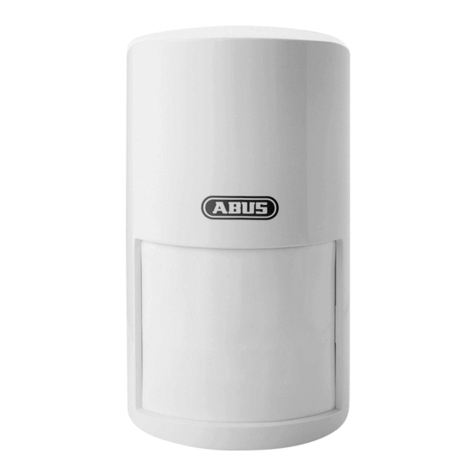
Abus
Abus FUBW35000A quick start guide
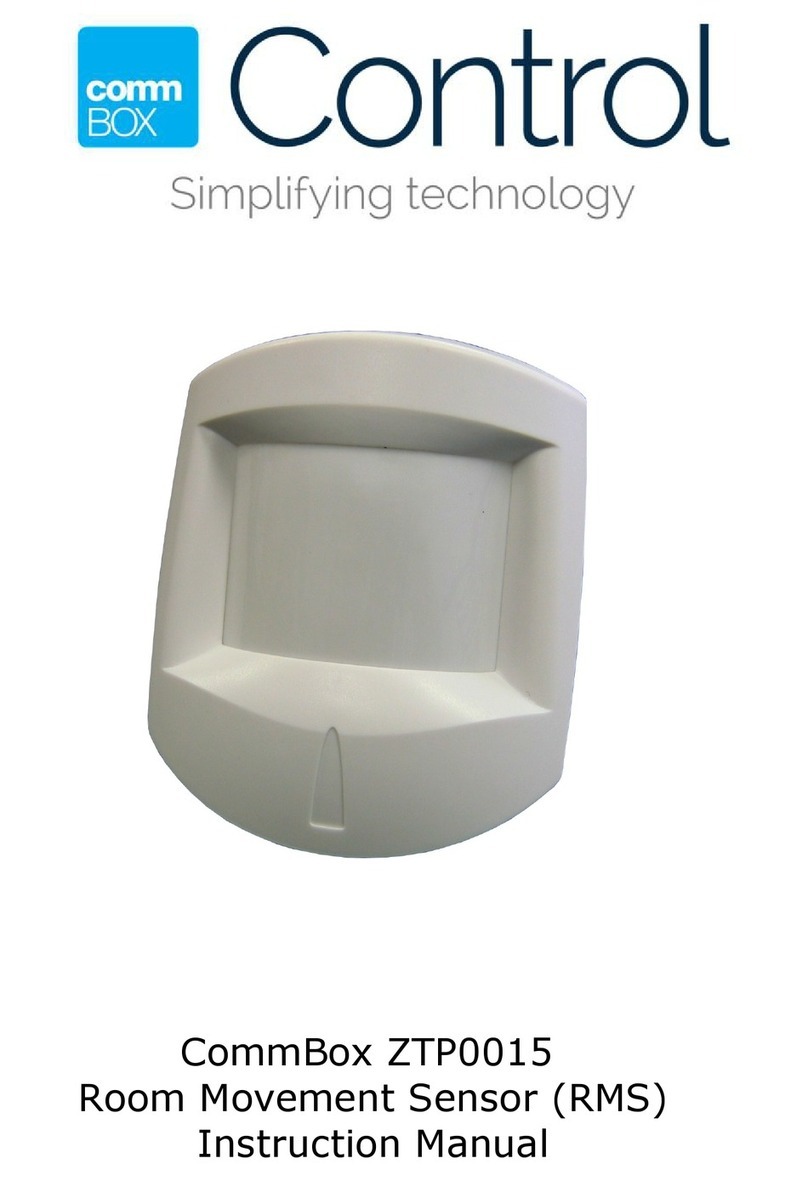
Comm Box
Comm Box ZTP0015 instruction manual
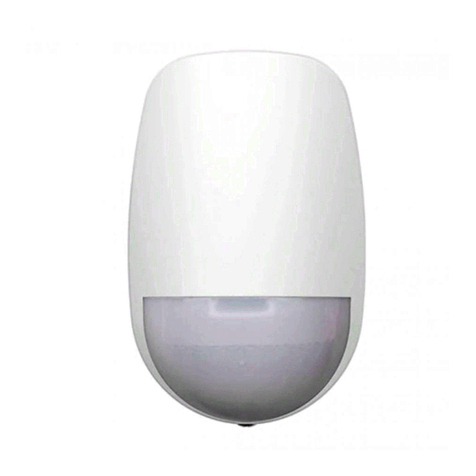
HIK VISION
HIK VISION DS-PDD12P-EG2-WB quick start guide
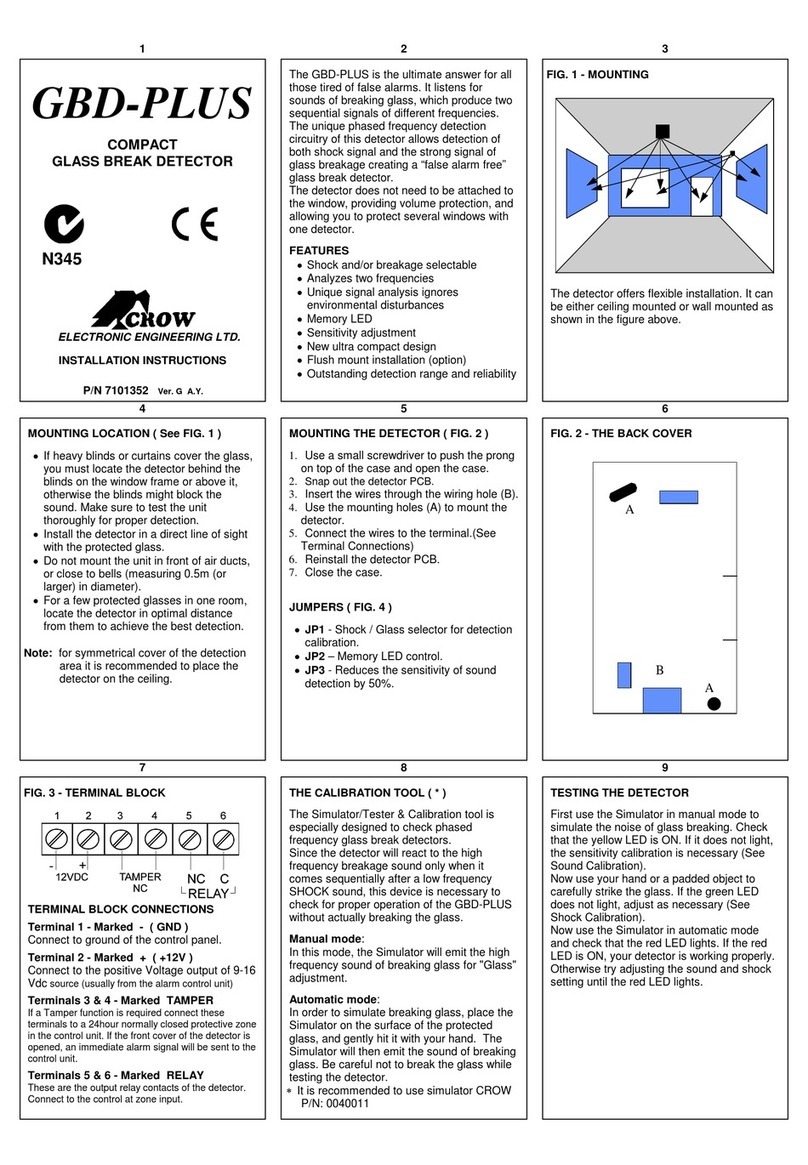
CROW ELECTRONIC ENGINEERING LTD.
CROW ELECTRONIC ENGINEERING LTD. GBD-PLUS installation instructions
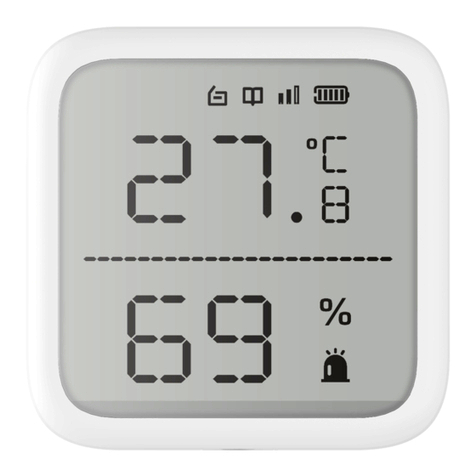
HIK VISION
HIK VISION DS-PDTPH-E-WE quick start guide
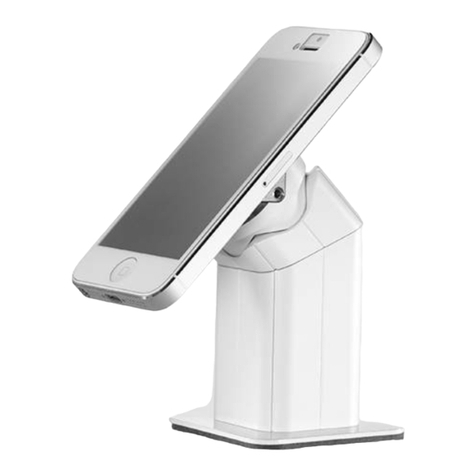
M-TI
M-TI ROGERS FREEDOM MICRO installation guide
